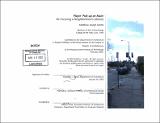| dc.contributor.advisor | Paul Lukez. | en_US |
| dc.contributor.author | Simitis, Matthew | en_US |
| dc.contributor.other | Massachusetts Institute of Technology. Dept. of Architecture. | en_US |
| dc.coverage.spatial | n-us-ma | en_US |
| dc.date.accessioned | 2012-04-27T17:34:27Z | |
| dc.date.available | 2012-04-27T17:34:27Z | |
| dc.date.copyright | 2002 | en_US |
| dc.date.issued | 2002 | en_US |
| dc.identifier.uri | http://hdl.handle.net/1721.1/70457 | |
| dc.description | Thesis (M. Arch.)--Massachusetts Institute of Technology, Dept. of Architecture, 2002. | en_US |
| dc.description | Includes bibliographical references (p. 57-61). | en_US |
| dc.description.abstract | At first glance, the city of Worcester is not unique. Like so many other New England cities, the traces of its industrial past are visible at every turn: from the early high-rise buildings in the downtown area, to the canals which run through the city, to the seemingly endless supply of bulky brick factories and the worker housing which surrounds them. Upon further investigation, however, Worcester, as with all places, is revealed to be filled with very specific, and indeed unique, histories and memories. Regrettably, in Worcester and so many of these other industrial cities, while many physical remnants remain, the spirit and energy they once provided have disappeared, much like the industries themselves. This disappearance has created a void in the cultural fabric of the area, leveling our experiences within cities and flattening the distinctions between them. Within Worcester, the neighborhood of Main south is indicative of this shift. Home to both universities and corset makers, for decades MainSouth held a singular position in Worcester's civic landscape - a place where higher education and the working classes mixed. After the loss of industry, however, the neighborhood disintegrated and any previous coherence disappeared. By utilizing forces already at work in the site, this thesis will attempt to promote a new understanding of Main south, one that re-establishes the neighborhood's identity as a place where different sectors of society can mix. Working with both existing building typologies and existing programmatic uses, a restructuring of portions of Main Street will be proposed as a new focal point for communal activity in the neighborhood. | en_US |
| dc.description.statementofresponsibility | by Matthew Joseph Simitis. | en_US |
| dc.format.extent | 63 p. | en_US |
| dc.language.iso | eng | en_US |
| dc.publisher | Massachusetts Institute of Technology | en_US |
| dc.rights | M.I.T. theses are protected by
copyright. They may be viewed from this source for any purpose, but
reproduction or distribution in any format is prohibited without written
permission. See provided URL for inquiries about permission. | en_US |
| dc.rights.uri | http://dspace.mit.edu/handle/1721.1/7582 | en_US |
| dc.subject | Architecture. | en_US |
| dc.title | Playin' pick-up on Main : refocusing a neighborhood's identity | en_US |
| dc.title.alternative | Playing pick-up on Main : refocusing a neighborhood's identity | en_US |
| dc.type | Thesis | en_US |
| dc.description.degree | M.Arch. | en_US |
| dc.contributor.department | Massachusetts Institute of Technology. Department of Architecture | |
| dc.identifier.oclc | 50530369 | en_US |
